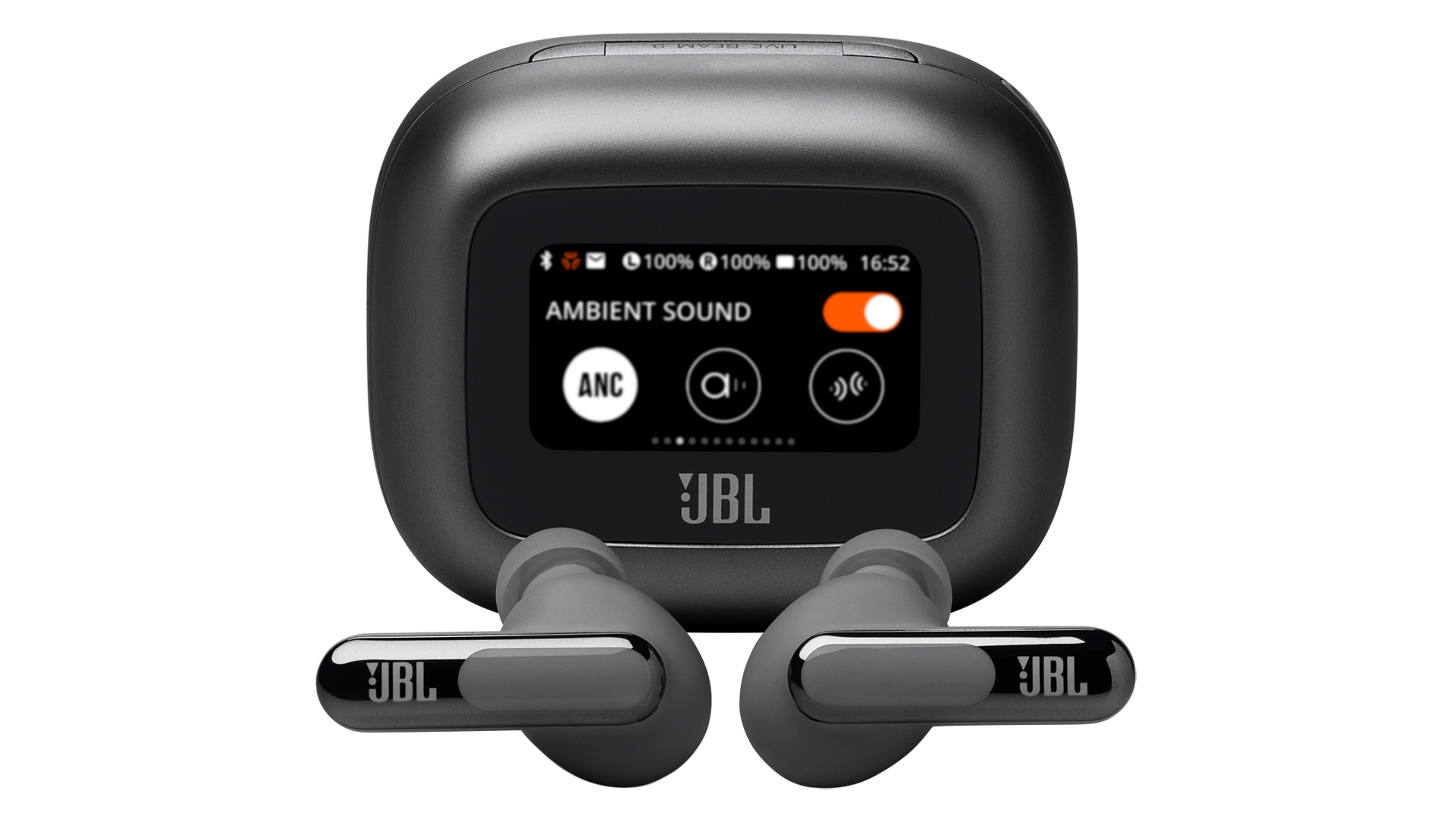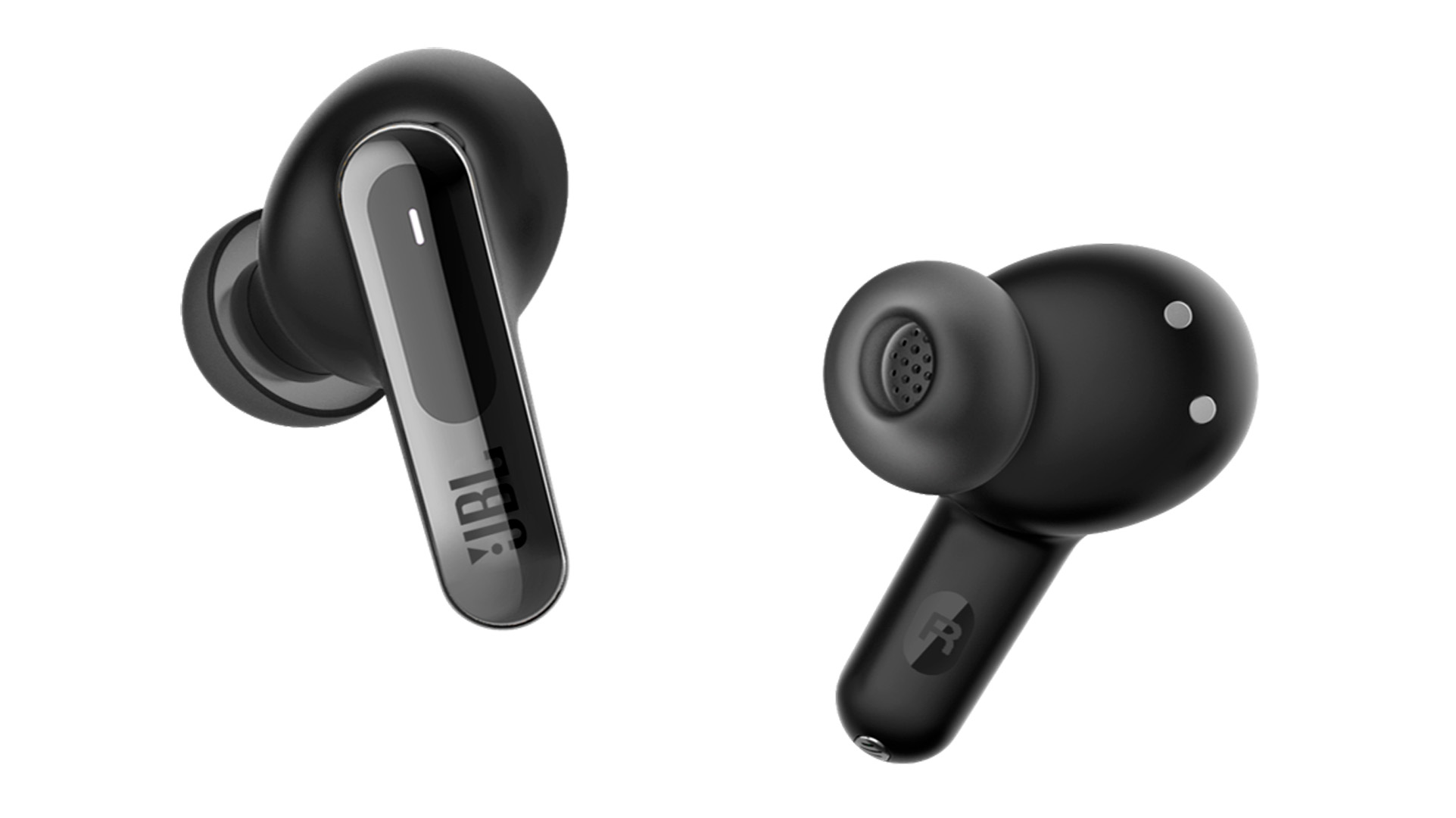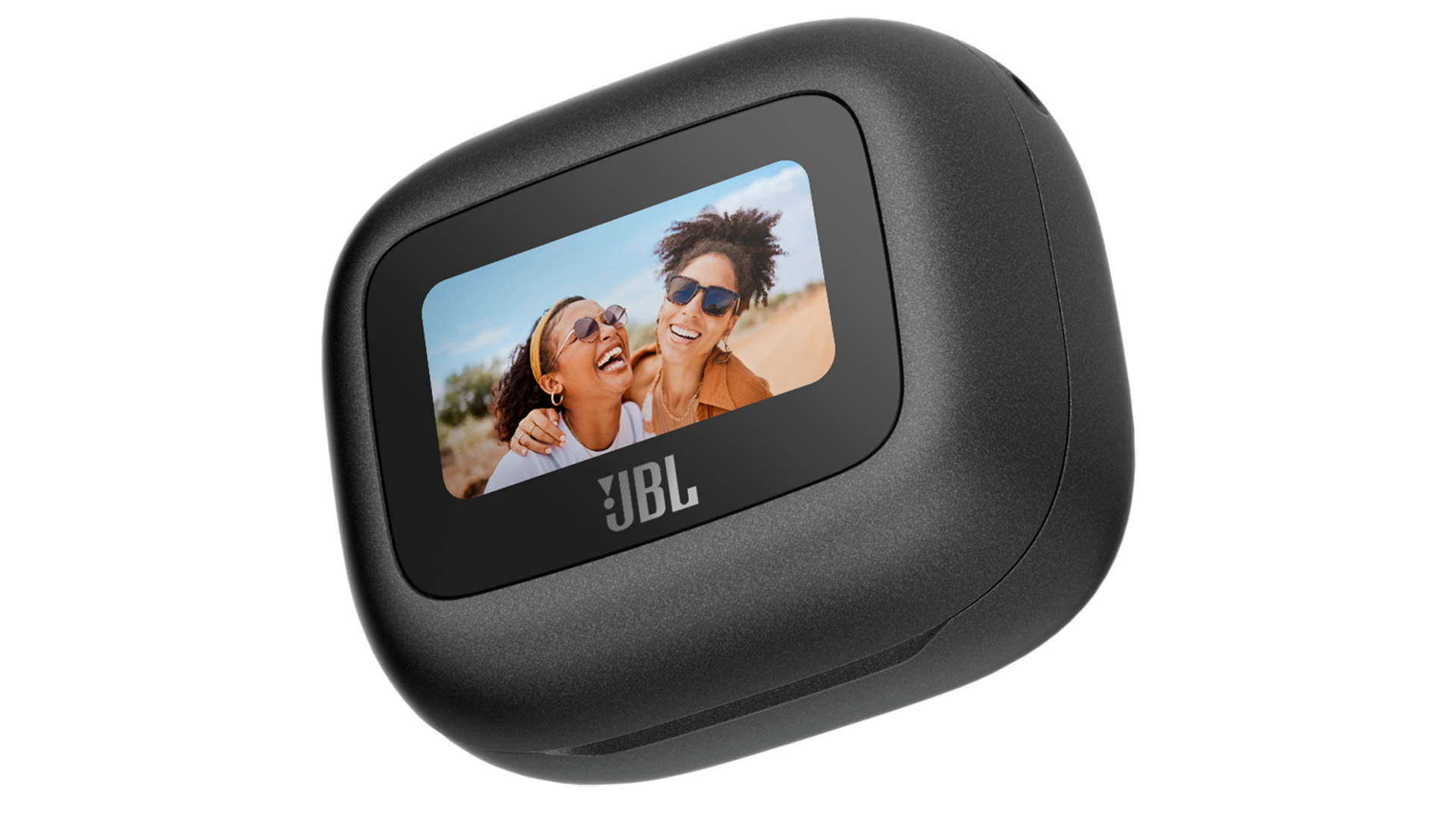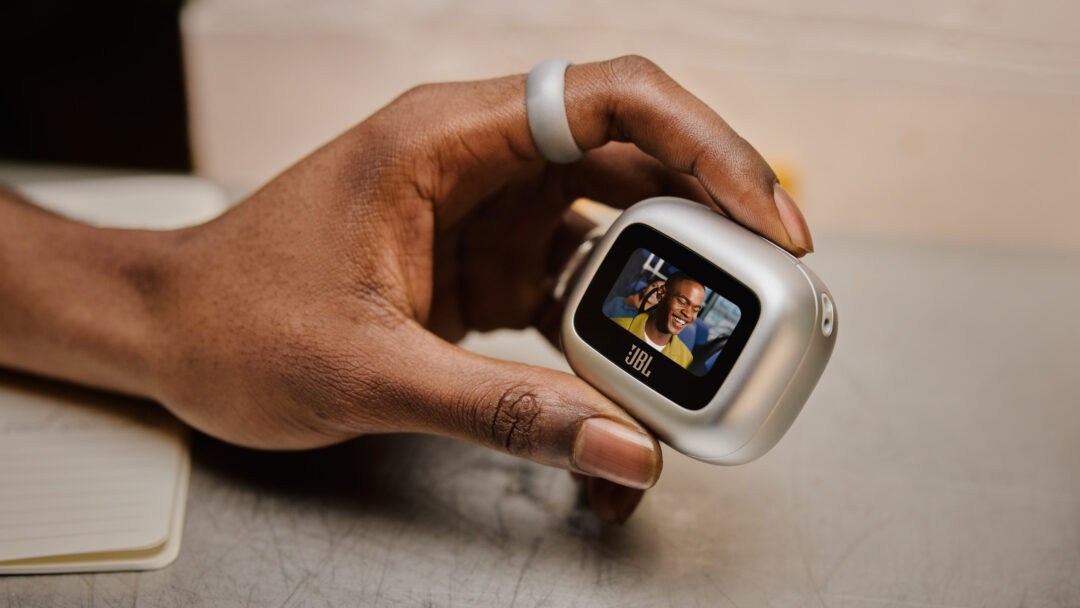JBL Live Beam 3 are completely wireless earbuds in the mid-price range. They are more than closely related to the JBL Live Buds 3, which we have also tested; in fact, the two are identical in most respects. But the purpose of this group review is to look at all three variants of the Live 3 – and for which applications they have different advantages and strengths.
JBL Live Beam 3 are slightly larger, elongated earbuds that don’t sit completely inside the ear canal, but protrude slightly forwards. The shape brings the microphone (or one of them) a little closer to the mouth, so you get slightly better conversation sound. The JBL logo discreetly adorns each earbud.
Like Live Buds 3 – and most other earbuds – the Live Beam 3 plugs need to be twisted into place in the ear canal for a stable and tight seal.
It was a little easier to get Live Beam 3 to be correctly orientated, as the elongated shape means they can only be fitted one way. There, however, they sat perfectly stable.
Pairing with a mobile phone or computer starts when the case is opened for the first time. Pay attention to which device they connect to first if several are nearby. It is possible to repeat the pairing later by following the manual.

The case does most of the work
Operating fully wireless earbuds can be challenging. Due to limited space, only the most basic controls are available on the plugs themselves, which typically means a single touch field. It can be difficult to adjust the buds without inadvertently activating or deactivating ANC, changing tracks or performing other actions by mistake.
This is where the charging case comes in as an almost perfect solution. In addition to being able to charge the earbuds three times, providing up to 40 hours of total playtime with ANC switched on, the case also includes a touch display. From the screen you can control all the most common functions, such as changing tracks, adjusting the volume and switching between ANC, ambient sound (where you can hear your surroundings while the music continues) and ‘TalkThru’ (where the music pauses so you can have a conversation).
Concise information
The screen on the case can display messages and notifications from your mobile phone. The idea is good, but the functionality is limited as text messages are only displayed briefly when received and you can’t scroll back.
The case also has features that don’t make sense on the small screen: the screen can be used as a flashlight, which most mobiles can do more effectively. In addition, the choice of menu language could just as easily be handled in the app.
The need to spontaneously switch between English and Chinese text is just an invitation for pranksters.
The case can be charged both with USB-C and wirelessly.

Comprehensive app
The JBL Headphone mobile app is without a doubt one of the most advanced and user-friendly control applications available for wireless headphones. The app is extremely comprehensive and its many features are quite simple and intuitive to navigate.
The Check My Best Fit feature uses a test tone to determine if the earbuds are close enough to the ear canal for optimal frequency response in the bass range.
The Personi-Fi feature is really smart – but in a slightly scary way. It tests the user’s hearing and then tries to correct the sound in the hearing aids to match the result.
The measurement is performed using test signals at different frequencies, which gradually become weaker until it is no longer possible to hear the sound.
JBL Live Flex 3 are open earbuds with ANC - not unlike some product from Cupertino.
Tests your hearing
After the PersoniFi measurement, the treble was louder, but I’m not sure if it was more satisfying. However, I do believe that we will see more hearing enhancement features in the future and that the difference between headphones and hearing aids will become more blurred.
The ability to switch to LDAC instead of the A2DP Bluetooth protocol provides cleaner and more detailed sound, even in mid-range earbuds like the JBL Live Beam 3.
By choosing LDAC, you lose some audio features in the app, such as spatial audio and Adaptive EQ, which boosts bass and treble at low volume. Personally, I’d gladly trade all the spatial audio in the world of earbuds for a single proper audio protocol like LDAC.
Variable noise cancellation
The noise cancellation in JBL Live Beam 3 can be configured in several ways. The user has the option to adjust the noise cancellation manually using a slider in the app or let the earbuds adjust the degree of attenuation based on the ambient noise level.
Any automatic noise cancellation will inevitably affect sound quality, as a higher degree of reduction results in a greater impact on sound quality. Therefore, there is no reason to use heavy active noise cancellation (ANC) in quiet environments. This functionality worked satisfactorily in practice.

The sound quality
The JBL Live Beam 3 is not among the company’s cheapest models, but the price is still affordable for most people, even on a pocket change budget. It’s remarkable how much sound quality you get for your money.
The sound is clear and the balance between the tonal ranges is well balanced. The bass is rich and appropriately heavy, voices are natural and the treble is detailed and well-defined. The product thus delivers sound quality fully in line with expectations.
The above rating is based on the most neutral Studio setting on the equalizer. If you want heavy bass in excess, there is a Bass setting for that. And an Extreme Bass setting if it’s still not heavy enough. I didn’t feel the need for it, but you can have it any way you want. And it’s also possible to create your own personalised equaliser curves.
JBL Live Buds 3 delivers everything most people want from a set of wireless earbuds. And the case is a winner.
The fact that I have no complaints about the sound of the JBL Live Beam 3 does not mean that they are the ultimate music reproducers and that all striving for naturalness should cease. I’ve certainly heard wireless headphones that revealed more technical details in the recording, but for a pair of affordable earbuds that should provide entertainment and peace from the outside world on the road, everything is as it should be.
Compared to competitors, the choice is huge and you get better noise cancellation with the slightly more expensive Sony WF-1000XM5, for example. For a third more, the Sennheiser Momentum True Wireless 4 has better sound. However, none of these have the really handy touchscreen on the charging case that JBL has.
Conclusion
JBL Live Beam 3 are excellent wireless earbuds in the mid-price range. The sound is great for the price and the app is one of the most comprehensive on the market. Best of all, the charging case doubles as a remote control.
In terms of sound, there is no difference between it and the Live Buds 3, but the ‘microphone extender’ makes the otherwise adequate call quality a little better. The price is a slightly larger earbud that is not as discreet. But it is easier to place in the ear, and the slightly larger housing means you get two hours more battery life in the bargain.

We think
They sound really good and the bass is rich and warm. The rod shape helps both the conversational sound and in-ear customisation. The touch screen on the case is a great help. Slightly larger than Live Buds 3. Not quite as discreet.
158 €
Specifications
- Type: In-ear, fully wireless
- Drivers: 10 mm
- Frequency range: 20 Hz – 40 kHz (tolerance not stated)
- Maximum volume: 96 dB
- Active noise cancellation: Yes, adaptive and with transparency mode
- Microphones: 3 per capsule
- Battery life: 10 hours with ANC (up to 40 hours with charging case)
- Protection: IP55 (earplugs)
- Charging: USB-C and wireless (case)
- App: JBL Headphones
- Control: App, touch fields on tips, case with 1.45’ touchscreen
- Spatial sound: JBL Spatial Sound
- Connectivity: Bluetooth 5.3 (A2DP 1.4, LDAC) with Multipoint
- Other: JBL Personi-fi 3.0
- Size and weight: 22.5 x 31.0 x 23.7.0 mm / 5 g per capsule
- Colours: Black, blue, silver, purple
- Web: jbl.com

